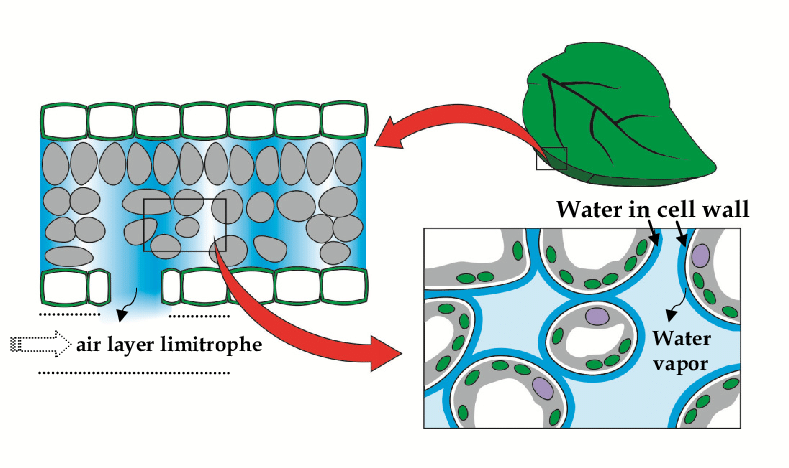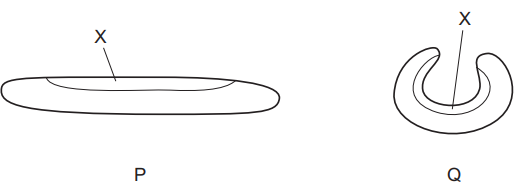Question
During transpiration, from where does the evaporation of water occur?
A intercellular spaces
B leaf surface
C mesophyll cell walls
D stomatal pores
▶️Answer/Explanation
Answer C

During transpiration, water evaporates from the moist cell walls of the mesophyll cells in the leaf. The mesophyll cells are the main site of photosynthesis in the leaf, and they have a large surface area that is exposed to the air spaces inside the leaf. Water evaporates from the cell walls into these air spaces, and then diffuses out of the leaf through the stomata.
Therefore, option C is the correct answer.
Question
When transpiration is at a maximum rate, tree trunks decrease in diameter.
Which statement explains this?
A There is decreased suction pressure in the leaves.
B There is less adhesion between water and xylem vessel walls.
C There is less water in the xylem vessels.
D The water in the xylem vessels is under increased tension.
▶️Answer/Explanation
Answer D
The correct answer is D. The water in the xylem vessels is under increased tension.
Transpiration is the process by which water is lost from the leaves of plants in the form of water vapor. During transpiration, water is pulled up through the xylem vessels from the roots to the leaves, driven by a combination of transpiration in the leaves and the cohesive and adhesive properties of water in the xylem.
When transpiration is at a maximum rate, the water in the xylem is under increased tension, which can cause the xylem vessels to narrow and the tree trunk to decrease in diameter. This is because the water is being pulled up through the xylem faster than it can be replaced by the roots, causing a negative pressure or tension in the xylem.
Therefore, option D is the correct answer.
Question
The diagram shows a xerophytic leaf in different conditions, P and Q.

Which statements about the cells in layer X of the leaf in each of the conditions P and Q are correct?
- less negative water potential in P than Q
- cells may be turgid in P and plasmolysed in Q
- cells less turgid in P than Q
- no net diffusion of water into X in either P or Q
- 1, 2, 3 and 4
- 1, 2 and 4 only
- 1 and 4 only
- 2 and 3 only
Answer/Explanation
Ans:
B
In xerophytic plants, the lower water potential reduces the evaporation of water from the cell surfaces as the water potential gradient between the cells and the leaf air spaces is reduced. Xerophyte adaptations increase water intake, limit water loss, and store water efficiently. Water intake adaptations include deep or widespread roots, and high salt content to increase osmosis. Xerophytes have thick cuticles, lost or finely divided leaves, reduced stomata, and CAM photosynthesis. In figure P, both water potential and turgidity are lower than in figure Q. Figure Q is turgid and in more sunken.
Question
Halophytes are plants that can survive in regions where they are regularly exposed to sea water. Sea water has a water potential of approximately –2500kPa.
What adaptations would you expect halophytes to show?
1. root hair cells that maintain a more negative water potential than sea water
2. root hair cells that accumulate salts and other solutes
3. stomata that are open most of the time
A. 1 and 2 only
B. 1 and 3 only
C. 2 and 3 only
D. 1, 2 and 3
▶️Answer/Explanation
Ans:
A
The correct answer is A. 1 and 2 only.
Halophytes are plants that can survive in regions where they are regularly exposed to sea water. Sea water has a water potential of approximately –2500 kPa. To survive in these conditions, halophytes have developed several adaptations:
1. Root hair cells that maintain a more negative water potential than sea water: Halophytes have root hair cells that maintain a more negative water potential than sea water. This allows them to absorb water from the soil despite the high salt concentration.
2. Root hair cells that accumulate salts and other solutes: Halophytes have root hair cells that accumulate salts and other solutes. This helps to maintain a more negative water potential in the root hair cells, which allows them to absorb water from the soil.
3. Stomata that are open most of the time: Halophytes have stomata that are open most of the time to allow for gas exchange and transpiration. However, this is not always the case, as some halophytes have evolved to keep their stomata closed during the day to reduce water loss.
Therefore, option A is the correct answer.
Question
Which feature of xylem vessel elements allows them to have reduced resistance to water movement?
- lignin forms an incomplete secondary wall
- new vessels carry extra water as a plant grows
- there are no cross walls between vessel elements
- vessel elements join to form narrow tubes
▶️Answer/Explanation
Ans:
C
The correct answer is C. There are no cross walls between vessel elements.
Xylem vessels are specialized cells that transport water and minerals from the roots to the leaves in plants. They are made up of several types of cells, including vessel elements.
Vessel elements are elongated cells that have a large diameter and are arranged end-to-end to form long tubes. These tubes are continuous, meaning there are no cross walls or perforations between the vessel elements. This feature allows for a continuous column of water to move through the xylem, reducing resistance to water movement.
Option A is incorrect because lignin forms a complete secondary wall, which provides structural support to the vessel element but also reduces its ability to transport water.
Option B is incorrect because new vessels do not carry extra water as the plant grows. Instead, the plant forms new vessels to accommodate its growth.
Option D is incorrect because vessel elements join to form wide tubes, not narrow tubes.
Therefore, option C is the correct answer.
